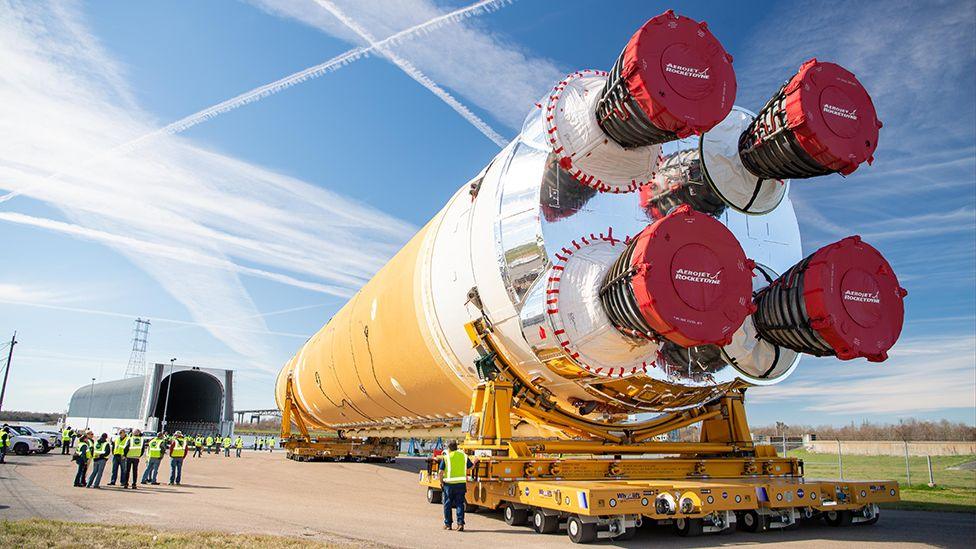Coronavirus: Nasa's Moon plans take a hit
- Published

The giant SLS core stage on the move in January from Michoud to Stennis
The fall-out from the coronavirus crisis is even being felt in space.
Rising infection rates near key technical centres in Louisiana and Mississippi mean the US space agency is suspending production and testing of its Moon rocket and capsule systems.
The Trump administration had set 2024 for the first crewed mission to the lunar surface in 50 years – an already challenging target.
That date looks even more optimistic now.
Nasa said it had no choice but to suspend work on the construction of the rocket, called the Space Launch System, and the capsule, known as Orion.
The Stennis Space Center in Mississippi has had one confirmed infection among its staff, and although the Michoud Assembly Facility in Louisiana hasn't yet had a COVID-19 case - growing infection rates in the communities around both complexes means a shut-down is the only sensible option.
Nasa Administrator Jim Bridenstine said staff were now moving to put hardware in a safe condition.
“We realise there will be impacts to Nasa missions, but as our teams work to analyse the full picture and reduce risks we understand that our top priority is the health and safety of the Nasa workforce,” he added.
Nasa Moon rocket core leaves for testing

Work is suspended also on the Orion crew capsule
Engineers had been transferring the first core stage of the SLS from Michoud to Stennis for a test firing, after which the plan then was to take it to the Kennedy Space Center in Florida for an uncrewed test flight.
The launch was being pencilled in for early next year. This mission, dubbed Artemis 1, would be followed by a crewed trip around the Moon, before the first planned landing, Artemis 3, in 2024.
Nasa has instigated teleworking across its organisation, but engineering work continues on a number of high-priority missions.
Key among these is the new Mars rover, Perseverance.
It's currently at Kennedy being prepared for a launch to the Red Planet in July/August.
This is a hard deadline for the robot. Because Earth-Mars journeys are only attempted when the planets are favourably aligned, the rover project will get bumped to 2022 if it misses the summer flight window.
Europe has already been forced into this position. Its Rosalind Franklin rover mission has been put back by 26 months.
The European Space Agency robot, a joint venture with Russia, was already struggling to meet its launch date because of a troublesome development schedule. But these difficulties were then further complicated by the inability of engineering teams to move around freely.

The Perseverance rover is being prepared for launch at Kennedy

EASY STEPS: What should I do?
A SIMPLE GUIDE: What are the symptoms?
SYMPTOMS: Should I self-isolate?
MAPS AND CHARTS: Visual guide to the outbreak
VIDEO: The 20-second hand wash

- Published9 January 2020

- Published5 March 2020
